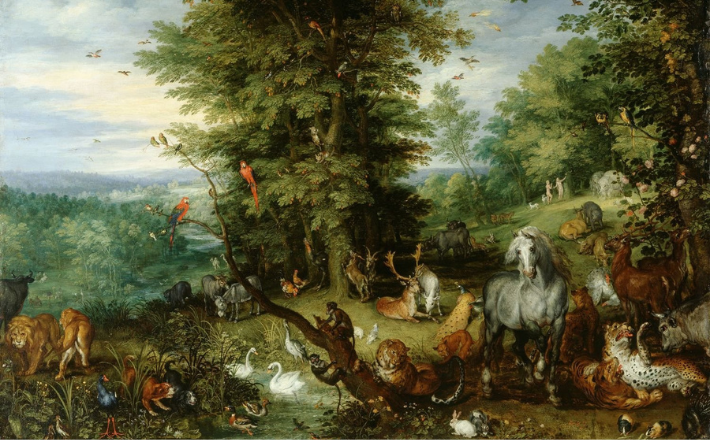Commentary on Genesis 2:4b-25
Genesis 2:4b-25 narrates part of a larger narrative that expands to the end of Genesis 3. These two chapters preserve a creation story and a story about the life of the first two humans in the garden of Eden. Pentateuchal scholarship is in flux, so some scholars consider these two chapters to be part of what is known as the Yahwist source, while other scholars, who question the existence of a complete Yahwist source, prefer to call these texts non-Priestly.
Either way, the narrative about creation that we find in Genesis 2:4b-25 is distinct from the Priestly creation story that is recounted in Genesis 1:1—2:4a. In addition to the difference in the order in which creatures are created, both stories have different modes, theological claims, and environmental worldviews. While God in the Priestly account of creation is portrayed as a transcendent deity who creates by the power of word, God in the non-Priestly (or Yahwist) creation story is an immanent deity who creates by action. Creation in Genesis 1 follows the Priestly worldview in which things are organized and orderly, while creation in Genesis 2 seems to be happening through a process in which God is more relational and improvising. The whole grand cosmos is the scope of the first description of creation, whereas the local agrarian realities of the garden grab the attention of the narrator of the second story of creation.
2:4a-17 Interdependent relations in the created world (humans, land, and plants)
The non-Priestly creation story weaves God’s creation as an interdependent web. Human and non-human creation, and even the deity are all caught up in a relational reality.
On the day the LORD (in other words YHWH) created the heavens and the earth, there were no plants or herbs (2:5). The reason why the fields were not producing yet has to do with the fact that it depends on the divine gift and human work. The deity has not caused rain to fall yet. This arid portrayal of the earth stands in stark contrast with the watery chaos that covered the face of the earth as we see in the Priestly story of creation in Genesis 1. The natural cycle of rain has not started yet. Relying on rain captures the fragility of the created order but also underlines its dependence on the deity to provide in due season. Also, the fields did not produce because there were no humans to serve the ground yet.
While Genesis 2:5d in the New Revised Standard Version reads “and there was no one to till the ground” captures the Hebrew correctly, it loses the important connection between humans and the earth. The Common English Bible captures this connection well “and there was still no human being to farm the fertile land.” The Hebrew text is artistically making a profound statement about the relationship between humans (’adam) and the ground (’adamah). Indeed, this same wordplay appears later in verse 7, when God creates the first human. From the dust of the earth (’adamah) God forms a human being (’adam). Humans are made from the earth and the earth depends on their work to produce. To capture this interdependence, some translations of Genesis 2 use the expressions “earthling” or “groundling” to translate the Hebrew word ’adam.
While Genesis 1:26 speaks of humans having dominion over the non-human creation, Genesis 2:5, 15 speak of human beings “serving” (‘bd) the land, caring for it. This shows that work has always been part of the divine design for human vocation, rather than a result of the disobedience that humans committed in Genesis 3. It also highlights that humans are not created to abuse the non-human creation. As much as the land needs humans in order to be productive, human survival depends on their service and care for the land. Thus, the LORD (YHWH) places the first human in the garden of Eden to serve it and care for it.
Creating humans to serve the earth solves one part of the problem. How will the Garden of Eden and the rest of the creation survive without water since there was no rain? Rather than a primordial water that needed to be tamed (Genesis 1:2, 6-12), Genesis 2 speaks of a mythical river that sustains Eden and out of Eden it gushes forth to form four rivers that go in different directions and make life possible in various geographical locations and topographies (2:10-14).
God is a farmer and so are humans (2:8, 15). Caring for the non-human creation is a gracious way through which God involves humans in the divine creative activity. Humans who breathe the divine breath are called to sustain life in the natural world around them. This very natural world, particularly the trees, are well knit with human destiny since both have their origin in the ground (’adamah; 2:7-9). Every tree that came out of the ground was pleasant and good. At the center of the garden that the first human was supposed to serve and keep, there was the tree of life and the tree of the knowledge of good and evil.
Given the divine restrictions on what humans should eat and what they should not and in light of the reflections here on the interdependence between human and non-human creation, one wonders if what is at stake here is greed and over consumption. Humans are permitted to eat from all of the trees, except for the tree of knowledge of good and evil. Humans are granted freedom and there is also a boundary set over them. If humans consume what they are not supposed to that affects their relationship with this harmonious Edenic reality. Breaking this boundary leads to death, which as we see in Genesis 3 does not refer to an immediate loss of life, but instead could possibly be referring to a disorder in the harmonious relationship between the different parts of the interdependent creation.
2:18-25 Interdependent relations in the created world (human and non-human animals)
The notion of interdependence continues to unfold in the narrative. Unlike Genesis 1, where God sees everything good, in Genesis 2:18, the deity acknowledges that it is not good for the first human to be alone. The solution that the LORD tried first was to create animals out of the ground (’adamah). As a potter, God forms (ytsr) humans out of the ground, and similarly God forms (ytsr) animals out of the ground. Animals are offered to the first human as a partner. In return, the human gives these creations names.
Even as this new relationship of interdependence does not fully succeed in providing a partner to the first human, both human and non-human animals are from the same source, created by the same God, and contribute to some extent to the way the other exists. The non-human animals were unable to be an equal partner. The same expression (‘zr) is used elsewhere to describe God as a helper (Psalm 121:2; Exodus 18:4), that is, there is no intrinsic hierarchy in the term itself. Because the non-human animals were unable to be an equal partner, the LORD (YHWH) had to interfere and continue the creative process. This sequence shows various things: 1. Not all interdependent relationships are of the same nature and value; 2. God is relational, tries solutions, and continues to engage when such solutions are insufficient; 3. The order of creation or when which creature was made does not entail any hierarchy as the author of 1 Timothy (2:13-14) implied, because while animals were created before the woman, this order does not give animals a precedence or hierarchy over the woman.
The LORD (YHWH) does not give up on the notion of interdependence that is embedded in partnership, thus God performs a surgery in which a side (usually translated as a rib) is taken from the first human to be made into another body. God closes the wound of the body of the first human, who then is called a man (‘ish) in contrast to the woman (‘ishah). Not only was the creation of the second human dependent on the body part of the first human, but also the first human in their loneliness is dependent on the creation of the second human. Another relationship of interdependence and partnership is formed in the garden of Eden. As two humans cling to each other’s body in sexuality, they move towards interdependence and away from the dependence of a child onto a parent.
Throughout the creation narrative of Genesis 2, interdependence is manifest not only among human and non-human creation, but it is also evident in how God operates in the created world. God relies on the rivers, the dirt, the animals, and the human body to fulfill God’s creative work in the world. In this way, the creator God calls on the created world to be relational.
This Edenic account of a harmoniously interdependent creation carries within it the notions of desire and curiosity, which lead to the inevitable boundary crossing with the deity and the rest of the creation. After Genesis 3, humans, non-human creation, and God will be entangled in a post-Edenic reality in which interdependence is not fully lost, but will be constantly threatened by greed, blaming the other, and violence. One way forward is for humans to transform the culture of over consumption and greed into an ecology of interdependence with non-human creation. This way they once more participate more fully in God’s creative work in the world.
PRAYER OF THE DAY
Holy Creator, you created women and men in your own image to till the earth and help one another. Give us hearts to continue tending to all that you have made so that the earth will sustain life for generations to come. Amen.
HYMNS
The God of Abraham praise ELW 831, H82 401, GG 49, UMH 116
Creating God, your fingers trace ELW 684, H82 394/395, NCH 462, UMH 109
Morning Has Broken ELW 556, GG 664, H82 8
Breathe On Me, Breath of God GG 286, H82 508, NCH 292, UMH 189
CHORAL
The Earth Adorned, Waldemar Ahlen


September 10, 2023